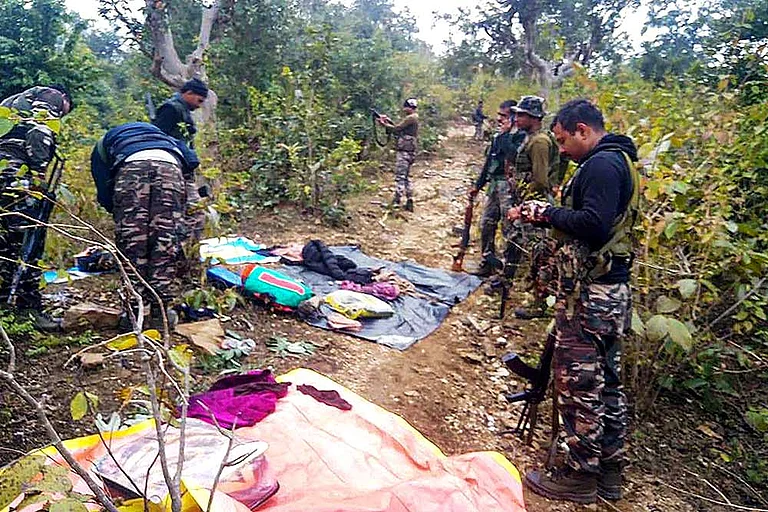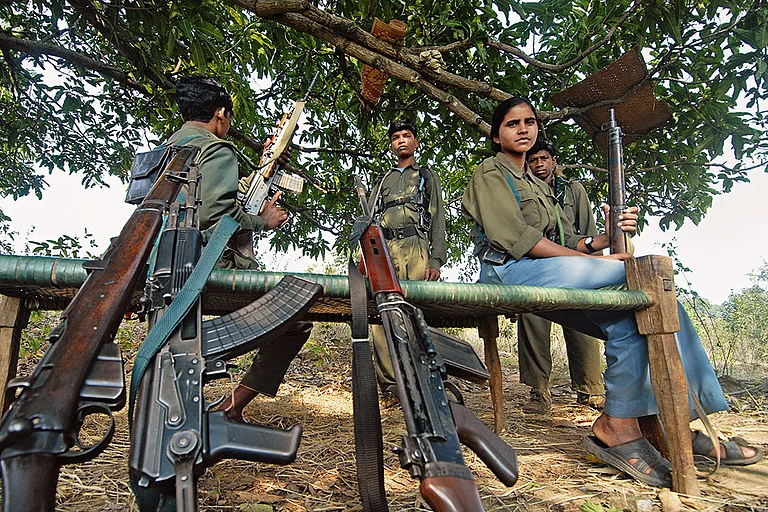The jungle quiet of Hapatola forest in Chhattisgarh’s Kanker district turned into a fierce gun battle on Tuesday afternoon where at least 29 Naxalites were killed and three security personnel were injured. The latest encounter is being seen as one of the biggest anti-Naxal operations in the region. The deceased also included a top Naxal leader, Shankar Rao, who had a bounty of Rs 25 lakh on his head and a large quantity of weapons was recovered from the spot. The encounter, which took place just days ahead of the Lok Sabha election, has added to the list of such gunfights in the Bastar region this year so far. As many as 79 Naxalites have been killed in separate gun battles with security forces across seven districts in Bastar, including Kanker this year so far.
For several decades now, Chhattisgarh has been a hotbed of violent clashes between Naxals and security forces, along with areas bordering the state in Maharashtra, Jharkhand and Odisha. Over the last 10 years, on the other hand, the government and security forces have also launched a series of crackdowns against Maoists, as a result of which retaliations have increased. While Home Minister Amit Shah hailed the Hapatola operation further vowing to “free the country from the scourge of Naxalism", it must not be forgotten that Naxals are only a recent vehicle of Adivasi defiance against the ingress of the governments on their lands.
Outlook takes a look at the major government operations and retaliatory attacks by Naxalites in the last decade.
Operation Green Hunt
Officially launched in 2009, Operation Green Hunt has continued to be a major anti-Naxal operation in the last 10 years as well. It is an “all-out offensive by paramilitary forces and the state forces” against Naxalites in the ‘Red Corridor’ along the eastern, central and southern parts of India including states like Jharkhand, Odisha, Chhattisgarh, Telangana, Bihar, Madhya Pradesh, Maharashtra and West Bengal.
Operation Prahaar
Operation Prahaar is the code name used by the police for targeted action against Naxal insurgents. Launched in 2017, it was a joint operation of Chhattisgarh Police and CRPF aimed to flush out Maoist-Naxalites from their strongholds and hideouts of Sukma and Bijapur districts of Chhattisgarh’s Bastar region. Thousands of security personnel from the CRPF, the STF, the DRG, and CoBRA were deployed for the operation.
Operation Hill Vijay
One of the lesser talked-about government initiatives, Operation Hill Vijay was launched in 2016 to eliminate Naxals from the hilly terrains of Jharkhand. It was launched alongside Parasnath Action Plan which also intended to flush out radicals and develop the area.
Operation Thunder
In May 2019, the CRPF and Maharashtra Police launched ‘Operation Thunder’, a joint anti-Naxal operation targeted at the Naxalite cadres and their bases in Gadchiroli district of Maharashtra. The operation also saw retaliation by the Maoist-Naxalite insurgents who killed at least 15 police and a civilian driver in a landmine attack on two security vehicles.
Operation Samadhan-Prahar
Operation Samadhan-Prahar is an ongoing counter-insurgency operation and a relatively new initiative of the Union government aimed to “combat Maoist insurgency in the tribal pockets of the country” and promote development initiatives. However, the operation has been met with protests by activists who have alleged that the operation was being used to eliminate Adivasi resistance using weapons. Several media reports have suggested that non-Maoist Adivasis in the region were killed in the operation.
Maoists or Naxalites have waged an armed insurrection against the Indian government for as long as 60 years now. But here are the major incidents of Maoist resistance in the last 10 years:
2017 Sukma Attack
In April 2017, an ambush was carried out by the Communist Party of India (Maoist) against Indian paramilitary forces during the Naxalite-Maoist insurgency. It was the largest ambush since 2010 when a similar attack had taken place in the neighbouring district of Dantewada. More than 300 Maoists had launched an offensive on a 99-member CRPF troop. At least three Maoists died, while 25 police personnel were killed in the attack.
2019 Gadchiroli bombing
On May 1, 2019, a landmine killed 15 Indian police personnel and their driver in Gadchiroli, Maharashtra in what they blamed to be a Maoist attack. The attack took place hours after Maoists had set 25 vehicles on fire at a road construction site in Kurkheda area of Gadchiroli in the middle of the night. Prime Minister Narendra Modi had condemned the attack saying the perpetrators would not be spared.
2021 Sukma-Bijapur attack
In April 2021, Naxalite-Maoist insurgents from the CPI-Maoist launched an ambush against Indian security forces at Sukma-Bijapur border near Jonaguda village in Sukma district of Chhattisgarh, killing 22 security personnel and 9 Maoists. The death toll was the highest since 2017 for Indian security forces fighting Naxalite insurgencies. It was a retaliation for a joint operation of security forces launched in Bijapur and Sukma district in the South Bastar forests.
2023 Dantewada bombing
On April 26, 2023, a bomb blast caused by an improvised explosive device (IED) took place in Chhattisgarh's Dantewada district killing a party of 10 District Reserve Guard (DRG) personnel of the Chhattisgarh Police and their driver, while they were returning from an anti-Maoist operation. According to reports, Maoists had received signals about the presence of the uniform-clad jawans when some locals stopped the vehicle just 100 meters from the site of bombing. Just days ahead of that, a convoy of Congress MLA Vikram Mandavi from Bijapur district came under Maoists’ fire while returning to Bijapur from a visit to a village in Gangaloor tehsil. No one was injured.




























